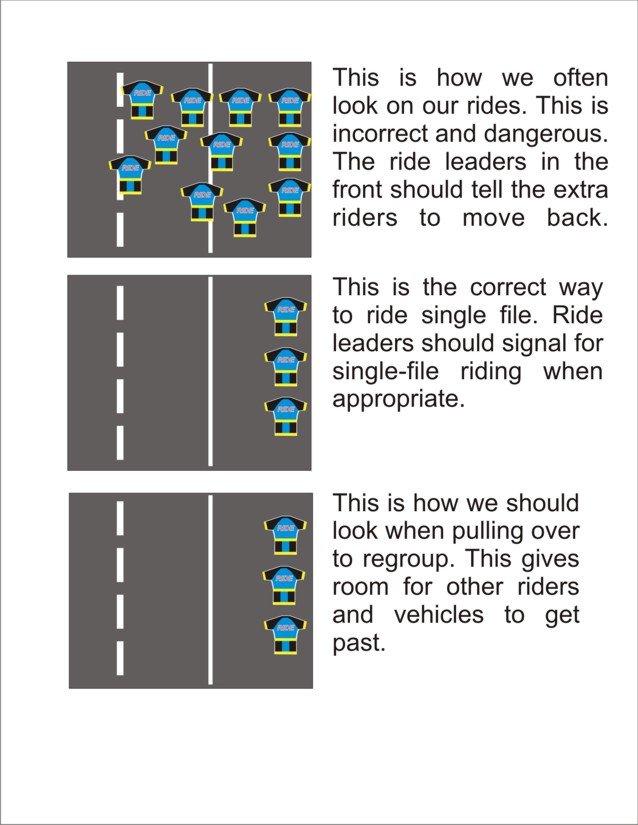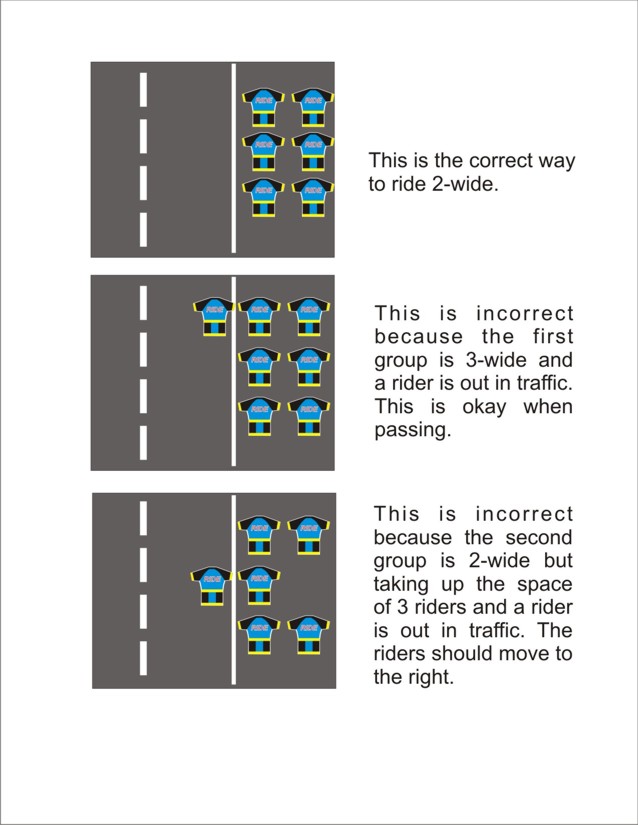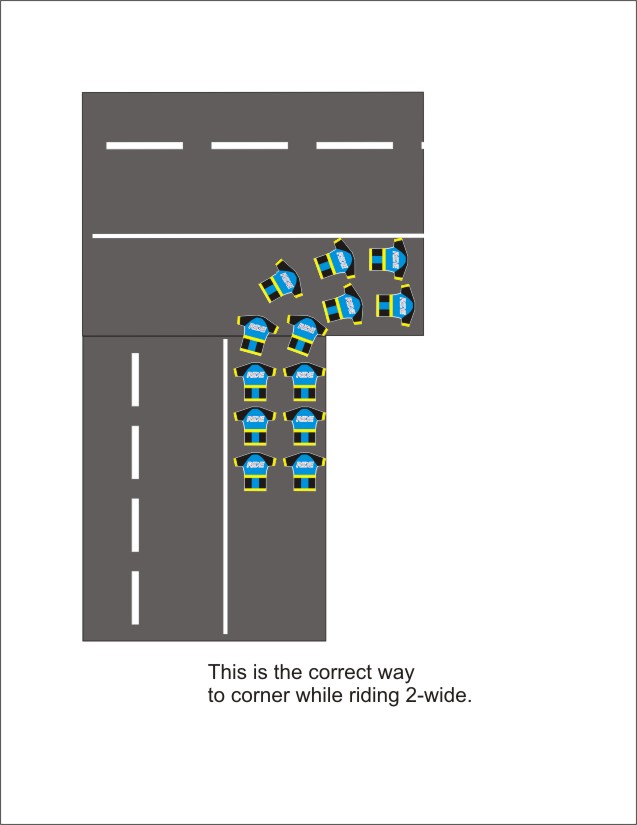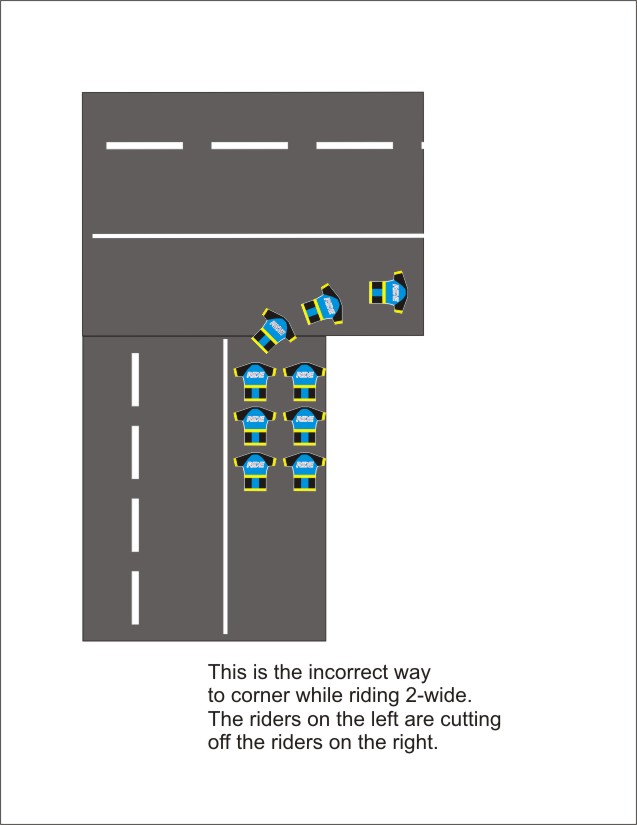All Ride Yourself Fit members are required to read, understand and follow Always The Safe Ride program.
As a part of this program, all members are asked to complete and sign the AlwaysThe Safe Ride agreement.
If you have not yet completed and signed this agreement, please open the link to the agreement below,
print and sign the document and bring it with you to the next ride. Thank you for your cooperation.
Always The Safe Ride Agreement
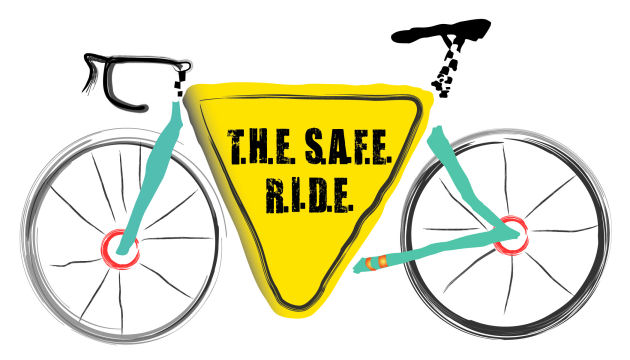
ALWAYS THE SAFE RIDE
Act as ambassadors of the bicycling community and Ride Yourself Fit while riding. Be courteous to others, including drivers
of vehicles and pedestrians. Thank drivers who allow riders to pass through an intersection.
Lights shall be used on all rides, flashing red on the rear and flashing white on the front. Make sure lights are bright by
recharging them between rides and/or replacing batteries as necessary.
Watch for debris and hazards in the roadway, including tree branches, broken glass, pot holes, loose sand/dirt and water.
Call out and/or point to such hazards and debris to other riders in the group.
Accept direction and guidance from designated ride leaders at all times on group rides. Do not start directing the
group ride unless permitted by the ride leader. If you are leaving the group for any reason, let the ride leader know.
You should ride with one or two “buddies” on all group rides. Buddies shall watch for each other and make sure that
all with the group are accounted for at stops and regroups. Buddies will make sure that no rider is left behind.
Stop from time to time to regroup and allow all riders to stay together. Let the ride leader know if a stop is needed for
a regroup or any other reason.
Talk to and communicate with your fellow riders, announcing turns and roadway obstacles either verbally or with
hand signals as necessary.
Helmets that are properly fitted must always be worn at all times while riding, no exceptions.
Examine your bike and always make sure it is in good working condition. Carry necessary tools and spare tubes
to make repairs when necessary.
Stop at all red lights and stop signs, follow and obey all traffic laws just as if you were driving a motor vehicle.
Yield to pedestrians crossing the street.
Announce yourself to fellow riders when approaching and passing, i.e. "on your left."
Familiarize yourself with the route before a ride. Carry a map, a route slip or program maps into your Garmin or Iphone.
Encroaching into another rider's line or path must be avoided. Hold your line on turns and corners.
Check on and be familiar with others riding around you before moving so you don't cross wheels and cut somebody off.
Ride with plenty of fluids, food, a phone, identification and money at all times.
Impeding vehicular traffic should be avoided. Ride as far to the right-hand edge of the road as safe and possible and
remain in bike lanes as long as it is safe. Call out "car back" to let riders in front know of vehicles approaching from the rear.
Defensive riding should always be practiced. Watch for vehicles at cross streets, driveways, and parking spaces.
Enjoy fun, fitness and fellowship with Ride Yourself Fit.
The Safe Ride "T"
Talk to and communicate with your fellow riders, announcing turns and roadway obstacles either verbally or with
hand signals as necessary.
Communication with your fellow riders is necessary to keep everybody safe. Verbal announcements and hand signals
can be used individually but are best used together. When approaching obstacles in the road (parked cars, pot holes,
tree branches, etc) please yell out the obstacle and point toward the general location of the object. Hand signals should
only be used when it is safe to remove a hand from the handlebars.
When passing a slower rider, please announce yourself so they know where you are.
When turning left or right, you can yell out "right turn" or "left turn" while pointing in the direction you plan to turn.
When slowing, put one hand behind your back with the palm open. When stopping, do the same except with a closed fist.
When the ride leader holds 1 finger above his head, this is the signal to ride single file. You may also hear "single file" being
yelled out. It will be helpful
to riders behind you if you also put 1 finger above your head and yell out "single file".
Be sure that if you call out, "Clear" it is actually clear for the riders immediately behind you. Also, be sure to check for yourself
that it is clear before proceeding into traffic.
The Safe Ride "H"
Helmets that are properly fitted must always be worn at all times while riding, no exceptions. The following website has
information on properly fitting your helmet. http://www.nhtsa.gov/people/injury/pedbimot/bike/EasyStepsWeb/
The Safe Ride "E"
Examine your bike and always make sure it is in good working condition. Carry necessary tools and spare tubes to
make repairs when necessary.
Some items you may want to have with you are as follows:
- Spare Tube
- Patch Kit
- Tire Levers
- Pump or CO2 inflator
- Multi-Tool
- Cell Phone
- ID, Money, Insurance Card
- Water or sports drink
- Food
- Route Slip
- Tweezers (to pull objects out of your tires when you flat)
- Rag (to wipe grease from your hands after a repair)
- Whistle (to signal riders ahead that you've had to stop)
- Pepper Spray
The Safe Ride "S"
Stop at all red lights and stop signs, follow and obey all traffic laws just as if you were driving a motor vehicle.
Yield to pedestrians crossing the street.
By law, we are required to follow all traffic laws just as we would if operating a motor vehicle. This means we
are subject to fines if we disobey laws such as stopping at red lights and stop signs.
The Safe Ride "A"
Announce yourself to fellow riders when approaching and passing, i.e. "on your left."
This is very easy but also very important. Announce yourself to riders you intend to pass loudly and clearly
so that they know where you are. It only takes a second and helps keep both you and the riders around you safe.
The Safe Ride "F"
Familiarize yourself with the route before a ride. Carry a map, a route slip or program maps into your Garmin or Iphone.
This rule should be self explanatory but there are still some riders that refuse to carry a route slip. Even if you just carry the route slip in your pocket, take one with you so that in case you get lost, you can find your way back.
The Safe Ride "E"
Encroaching into another rider's line or path must be avoided. Hold your line on turns and corners. Check on and be familiar with others riding around you before moving so you don't cross wheels and cut somebody off.
Keep your line so that you don't cut off other riders. This is especially important in corners. Cutting the corner may mean cutting off another rider. Every now and then, check around you so you know where other riders are. If you see an obstacle coming up and know you will need to move over, let those other riders know that you are coming over so that they can make room for you.
The Safe Ride "R"
Ride with plenty of fluids, food, a phone, identification and money at all times.
Food and fluids are a must for energy to complete your ride. It's a good idea to bring along a little extra food. You never know when you might want to take your ride a little further. You may also come across another rider that needs something to eat.
A phone is necessary if you get into trouble, get lost (shouldn't happen if you have a route slip), or need to report something you see on the ride.
Identification, whether it be a Road ID bracelet or an ID card, is important to keep on you in case of an accident. If you only carry an ID, be sure to bring along your emergency contact info.
Always bring along some money. It's good to have if you need to get something to eat, stop by the bike shop for supplies, or even to temporarily plug a hole in a blow out.
The Safe Ride "I"
Impeding vehicular traffic should be avoided. Ride as far to the right-hand edge of the road as safe and possible and remain in bike lanes as long as it is safe. Call out "car back" to let riders in front know of vehicles approaching from the rear.
Just as cars are supposed to share the road with us, we should share it with them. Stay to the right as long as it is safe and give cars plenty of room to get around you.
The Safe Ride "D"
Defensive riding should always be practiced. Watch for vehicles at cross streets, driveways, and parking spaces.
Continually scan for cars that may not see you. Make eye contact with the driver and even wave at them to make sure they see you.
The Safe Ride "E"
Enjoy fun, fitness and fellowship with Ride Yourself Fit.
Have fun on the ride and come back safely.
|
Stay to the right and allow room for those who are traveling faster than you to pass on your left. This also applies to riding on trails.
The law states that people on bikes should ride as far right as practicable, but what exactly does that mean?
It does not mean that you have to ride in the gutter -- never ride there. If you’re on a road that is too narrow to share with another vehicle, you should be in the middle of the lane. You do not want to give motorists the opportunity to try to squeeze past you. When the lane is wide enough to share (around 14 feet), you should place yourself three feet away from traffic.
|
|
Scanning is simply the act of looking over your shoulder.
Scanning successfully is a key part of riding anywhere—it’s an easy and safe way to communicate your intentions to others and it also shows you what is happening behind you.
At first, it will be difficult to scan and maintain a straight line. A tip that may keep you from pulling the bike is to remove the hand, from the direction you are scanning, from the handlebars.
|
| |
Starting and stopping your bike smoothly will tell others that you are competent and belong on the road.
Steps to Starting Your Bike
- Stand ahead of the seat
- Place one pedal in an upright position
- Push the pedal down and ease yourself onto the seat
- Place the other foot on the opposite pedal
Steps to Stopping Your Bike
- Stop pedaling
- Shift your weight to the pedal that is in the down position
- Squeeze both brakes equally
- Slide off the seat
- Place one food on the ground
|
|
You should always let others know when you are turning, changing lanes or stopping.
Communicating your intentions not only makes your ride safer, but it is also required by law in the United States.
Left Turn: Fully extend your left arm out to the side
Right Turn: Fully extend your right arm out to the side or bend your left arm up at a right angle with your hand flat.
Slowing or Stopping: Extend your left arm out at a right angle with your hand open for slowing and closed for stopping.
|
| |
Changing lanes in traffic can be challenging. Here’s how you can change lanes with confidence:
- Plan ahead, anticipate where you are going to need to be on the road
- Look behind you, possibly several times
- Signal where you are going
- Act carefully, smoothly and deliberately
|
|
Since most crashes happen at intersections, be sure to reduce your risk by being visible, positioning yourself clearly on the road, and making eye contact with other drivers.
When you are coming up to a multi-lane intersection, you will want to be in the right-most lane that is traveling in the direction you are going. Where you are within the lane depends on the intersection.
|
|
A bike lane is a striped and signed lane that provides a dedicated space on the road for people on bikes. They should be used the same as any other travel lane, so follow the same rules of the road.
Things to look out for:
• Parked cars. Be sure you ride far enough over to stay clear of an opening car door
• Vehicles that are turning right without a signal
Even if your community has a law that says you have to ride in a bike lane, there are exceptions:
• Making a left turn
• Passing another bicyclist
• Going around hazards
As with any other lane changes, be sure to first scan, signal and yield.
|
|
Drive your bike as you would any vehicle.
In all 50 states, people on bikes are required to follow the same laws as other drivers.
Here are a few key principles that underpin all US traffic laws:
First Come, First Served
Everyone on the road is entitled to the lane width they need. This includes the space behind, to each side and the space in front. If you want to use someone else’s space you must yield to whoever is using it.
Ride on the Right
In the United States, everyone must drive on the right-hand side of the roadway.
Yielding to Crossing Traffic
When you come to an intersection, if you don’t have the right of way, you must yield.
Yielding when Changing Lanes
If you want to change lanes, you must yield to traffic that is in your new lane of travel.
Speed Positioning
The slowest vehicles on the road should be the furthest to the right. Where you position yourself on the road depends on the location of any parked cars, your speed, and your destination. Always pass on the left.
Lane Positioning
Bikes can share the same lane with other drivers. If a lane is wide enough to share with another vehicle (about 14 feet), ride three feet to the right of traffic. If the lane is not wide enough to share, “take the lane” by riding in the middle.
Intersection positioning
When there is a lane that is used for more than one direction, use the rightmost lane going in the direction you are traveling.
Follow all street signs, signals, and markings
|
|
Since the path can be congested it’s important to follow the same rules as everyone else in order to have a safe and enjoyable time.
• Be courteous
• Know the rules of the trail you are using
• Give a clear signal when passing
• Be cautious and yield to crossing traffic
• Always be predictable by riding in a straight line
• If you are riding while it is dark, be sure to use lights
• Only use half the width of the trail
• Keep it clean
|
 |
Tired of dodging pot holes on your rides in Redlands?
Let the city know with the Redlands311 app.
You can report problems such as pot holes,
downed trees, etc. from your smart phone or computer.
Click the following link for info.
http://www.cityofredlands.org/311
|
Bicycles
Bicyclists:
- Are entitled to share the road with motor vehicles.
- Have the same rights and responsibilities as vehicle and motorcycle drivers.
- Must obey all traffic signals and stop signs.
- Are lawfully permitted to ride on certain sections of roadway in rural areas where there is no alternate route.
- Must ride in the same direction as other traffic, not against it.
- Shall ride as near to the right curb or edge of the roadway as practical – not on the sidewalk.
- Are legally allowed to ride in the center of the lane when moving at the same speed as other traffic.
- May move left to pass a parked or moving vehicle, bicycle, animal, or avoid debris or other hazards.
- May choose to ride near the left curb or edge of a one-way street.
- Should ride single file on a busy or narrow street.
- Must make left and right turns in the same way drivers do, using the same turn lanes.
- If the bicyclist is traveling straight ahead, use a through traffic lane rather than ride next to the curb and block traffic making right turns.
- Must signal all their intentions to motorists and bicyclists near them.
- Must wear a helmet if under the age of 18.
- Should carry identification.
- Shall not operate a bicycle on a roadway unless the bicycle is equipped with:
- A brake which will enable the operator to make one braked wheel skid on dry, level, clean pavement.
Turns for bicyclists Intersections with Special Lanes
*****Emergency Vehicles*****
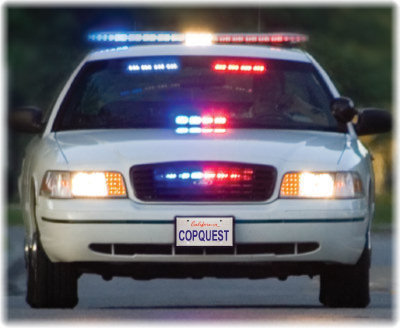 |
|
Cyclists are required to pull over to the right
and stop when emergency vehicles
with lights and sirens activated are
approaching from either direction,
just as you are when driving a car.
|
*****WEDNESDAY EVENING RIDES*****
|
After sunset, bicyclists on RYF rides must have the following equipment:
-
A front lamp emitting a white light visible from a distance of 300 feet.
-
A rear red reflector visible from a distance of 500 feet.
-
A white or yellow reflector on each pedal or on the bicyclist’s shoes or ankles visible from a distance of 200 feet.
|
|
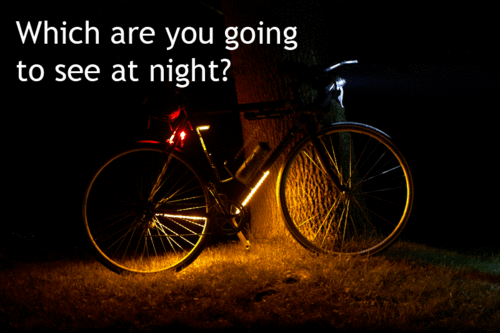 |
How to ride in a group
